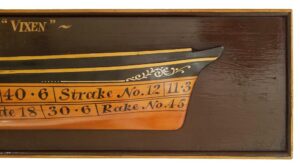Half Hull Model of Royal Navy
Iron Ship
HMS “Vixen”

Dimensions:
Backboard 45 1/4″ L x 10″ Ht.
Ship: 34 /4″ L x 4 3/4″ D x 2 3/4″ Beam
Weight: 12 Lbs
Presented is a fine beautifully decorative Half Hull Model of the Royal Navy Iron Ship HMS “Vixen”. This fine half hull has the appearance of a builders plating model, but was made by an English artesian in the 1950’s and is a reproduction.
HMS Vixen was an armoured composite gunboat , the only ship of her class, and the third ship of the Royal Navy to bear the name. She was the first Royal Navy vessel to have twin propellers. Designed by the Admiralty, Vixen was an armoured gunboat of the breastwork type. Her hull was of composite construction, with iron frames and iron bulwarks, but with an outer cladding of 140 mm (5.5 in) teak over the entire hull. An armoured citadel protected her machinery and the ram bow was reinforced by massive ironwork structures. Underwater, her hull was sheathed in copper to prevent marine growth. Vertical trunks were provided at the stern to lift the screws clear of the hull, thereby allowing a better hull-form for purely wind-driven sailing. She was equipped with two sets of 4-cylinder horizontal single-expansion steam engines, each set powering one of her two-bladed, 9 ft diameter Maudslay & Griffiths screws. In total she developed an indicated 740 horsepower, sufficient for a top speed of 8.9 knots (16.5 km/h). Steam was provided by two Maudslay iron fire-tube boilers with six furnaces.
 |
 |
She was equipped with a barquentine rig, but in 1873 all masts, rigging and upper deck obstructions were removed after the decision for Vixen and Viper to remain permanently in Bermuda. Vixen was armed with two 7-inch (6½-ton) muzzle-loading rifled guns and two 20-pounder breech-loading rifled guns. One of Vixen or Viper‘s 7-inch guns was displayed on the waterfront at St. George’s as recently as 1991.
Although turning ability was impressive, none of the ships attained more than 9+1⁄2 knots (17.6 km/h) in an era when “Warrior” could achieve 14+1⁄2 knots. (Warrior is on exhibit at the Royal Naval Shipyard Museum in Southampton, UK) Vixen was nearly lost in the Irish Channel during a winter gale in 1876, making her unsuitable for the open sea under steam or sail. Vixen and Viper were towed to Bermuda in 1868 where they operated within the reefline as floating defensive batteries, extending the defences of the Royal Naval Dockyard, Bermuda.
1873 saw the loss of all rigging, masts and upperdeck equipment, and this must have helped her to survive the 1878 hurricane which caused serious damage to the floating dock and other dockyard facilities. December 1895, Vixen had been sold to a local scrap merchant. Once her engines had been removed, she was placed across the Chubb Cut and massive scuttling charges were detonated. She now serves as a tourist attraction for Bermuda visitors for divers and glass bottom boats.

Back of Backboard
